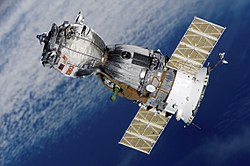| Operator | Roscosmos |
|---|---|
| COSPAR ID | 2011-067A |
| SATCAT no. | 37877 |
| Mission duration | 165d, 07h, 31m |
| Spacecraft properties | |
| Spacecraft type | Soyuz-TMA 11F732 |
| Manufacturer | Energia |
| Crew | |
| Crew size | 3 |
| Members | Anton Shkaplerov Anatoli Ivanishin Daniel C. Burbank |
| Callsign | Astraeus |
| Start of mission | |
| Launch date | 14 November 2011, 04:14:03 UTC [1] |
| Rocket | Soyuz-FG |
| Launch site | Baikonur 1/5 |
| End of mission | |
| Landing date | 27 April 2012, 11:45 UTC [2] |
| Orbital parameters | |
| Reference system | Geocentric |
| Regime | Low Earth |
| Docking with ISS | |
| Docking port | Poisk zenith |
| Docking date | 16 November 2011 05:24 UTC |
| Undocking date | 27 April 2012 08:15 UTC |
| Time docked | 163d 2h 51m |
 From left to right: Daniel C. Burbank, Anton Shkaplerov and Anatoli Ivanishin Soyuz programme (Crewed missions) | |
Soyuz TMA-22 was a crewed spaceflight to the International Space Station (ISS). TMA-22 was the 111th flight of a Soyuz spacecraft, and transported three members of the Expedition 29 crew to the ISS. The spacecraft docked to the ISS on 16 November 2011, [3] and remained docked to serve as an emergency escape vehicle until its undocking on 27 April 2012. [4] Soyuz TMA-22 successfully landed in Kazakhstan on 27 April 2012 11:45 GMT. [2]
Contents
- Crew
- Backup crew
- Mission profile
- Rescheduling of launch
- Launch
- Docking
- Deorbit
- References
- External links
TMA-22 was the final flight of a Soyuz-TMA vehicle, following the design's replacement by the modernized TMA-M series. [5] The launch of Soyuz TMA-22 was originally scheduled for 30 September 2011, but was delayed until 14 November following the launch failure of the Progress M-12M resupply vehicle on 24 August 2011. [6] Soyuz TMA-22 was the first crewed mission to dock with the ISS since the Retirement of the American Space Shuttle fleet at the end of the STS-135 mission in July 2011.








